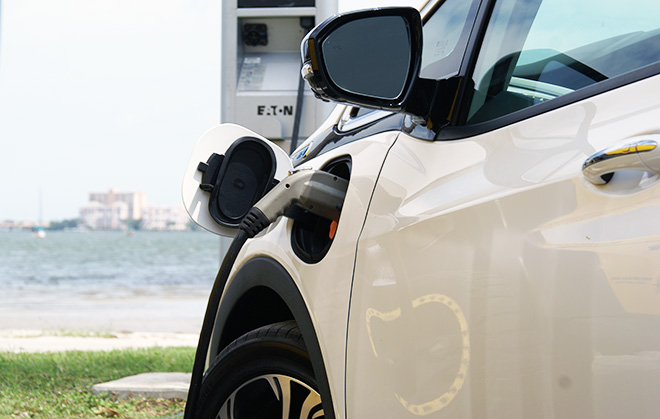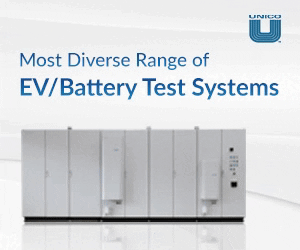When it comes to new technology, public perceptions matter. Expert opinions differ on the importance of public EV charging infrastructure, but potential EV buyers tend to see it as absolutely critical, as numerous surveys have made clear.
Utilities around the country are installing public EV chargers, and the savvy ones understand that the value of such projects goes beyond the direct revenue that they generate.
Peter Westlake is the Manager of New Products and Services at the Orlando Utilities Commission (OUC), which has installed hundreds of public charging stations. As he explained to Charged in a recent interview, EVs represent an enormous new revenue opportunity for utilities—and one way to encourage EV adoption is to install lots of highly-visible public chargers.
If someone only spends $100 with me yearly to charge their vehicle at one of my [public] chargers, I’m still probably going to see in the neighborhood of an additional $400 or $500 in home charging.
“As a utility, I have the unique opportunity to look at the whole story behind an EV charging hub,” Westlake told us. “If someone only spends $100 with me yearly to charge their vehicle at one of my [public] chargers, I’m still probably going to see in the neighborhood of an additional $400 or $500 in home charging.”
Even if the OUC loses a little bit operating the chargers, it’s still winning, because making the chargers available encourages EV adoption overall. “No matter who operates the charging stations, we’re the energy source, as long as they’re within our service territory,” says Westlake. “And honestly, I would love it if charging operators like bp pulse and Tesla come into our territory and build out the charging hubs, because OUC doesn’t necessarily need to be in the charging business. We need to be in the energy business. But I also know that, if you look back at the history of gas, when automobiles first started out in the early teens, they sold gas at hardware stores and grocery stores and pharmacies and things like that. It wasn’t until Texaco actually started to build gas stations that the fuel ended up in the right spot.”
Furthermore, public charging—especially DC fast charging—may not always be a loss leader. “If we look at a Tesla charging hub that’s operating in our service territory, it drives a fairly significant revenue opportunity,” says Westlake. “Those are operating in the black very quickly after being installed. We took a charging hub live in July that features 20 CCS DC fast charging stations—it’s located in the heart of downtown Orlando. We believe that it will at least break even, if not better, in the near future. And that’s because, as you get the load up, you start to see more revenue come in.”


order lasuna online – buy generic himcolin himcolin order
buy generic besivance for sale – buy besifloxacin without a prescription order sildamax generic
celecoxib 200mg price – cheap indocin 75mg buy indomethacin 50mg online cheap
buy cheap mebeverine – buy cilostazol generic order cilostazol 100 mg online cheap
buy voltaren – order diclofenac 50mg online generic aspirin 75 mg
buy rumalaya cheap – purchase endep sale buy amitriptyline 10mg generic
mestinon ca – imuran 50mg sale order imuran 50mg pills
buy voveran online cheap – nimotop online buy nimotop cheap
lioresal order – buy ozobax online piroxicam tablet
buy mobic pills – toradol without prescription order toradol online
cheap periactin 4 mg – buy periactin 4mg without prescription zanaflex oral
buy trihexyphenidyl pill – buy trihexyphenidyl pills purchase voltaren gel
cefdinir 300mg ca – buy generic cleocin online cheap clindamycin
isotretinoin 40mg uk – oral dapsone 100mg deltasone usa
prednisone online – elimite order buy elimite generic
permethrin order online – benzac price order tretinoin cream online
oral betamethasone 20 gm – order betamethasone generic buy monobenzone without prescription
buy flagyl paypal – buy cenforce 50mg online cenforce 100mg us
clavulanate sale – buy augmentin pill order generic synthroid
cleocin 150mg price – purchase cleocin for sale order indocin without prescription
losartan 25mg cost – hyzaar pills cephalexin 250mg uk
buy eurax cream – order bactroban ointment sale cheap aczone
order provigil 100mg pills – cheap modafinil 200mg meloset 3 mg us
zyban online order – cheap xenical 120mg cheap shuddha guggulu tablets
order xeloda 500mg sale – buy xeloda 500 mg without prescription danocrine 100 mg tablet
order progesterone without prescription – generic prometrium buy clomiphene for sale
aygestin 5 mg pills – purchase lumigan online cheap yasmin
purchase estradiol for sale – anastrozole uk order arimidex 1mg sale
cabergoline online – purchase alesse sale buy alesse online cheap
гѓ—гѓ¬гѓ‰гѓ‹гѓійЂљиІ©гЃ§иІ·гЃ€гЃѕгЃ™гЃ‹ – イソトレチノイン通販 г‚ўг‚гѓҐгѓ†г‚¤гѓійЊ 20 mg еј·гЃ•